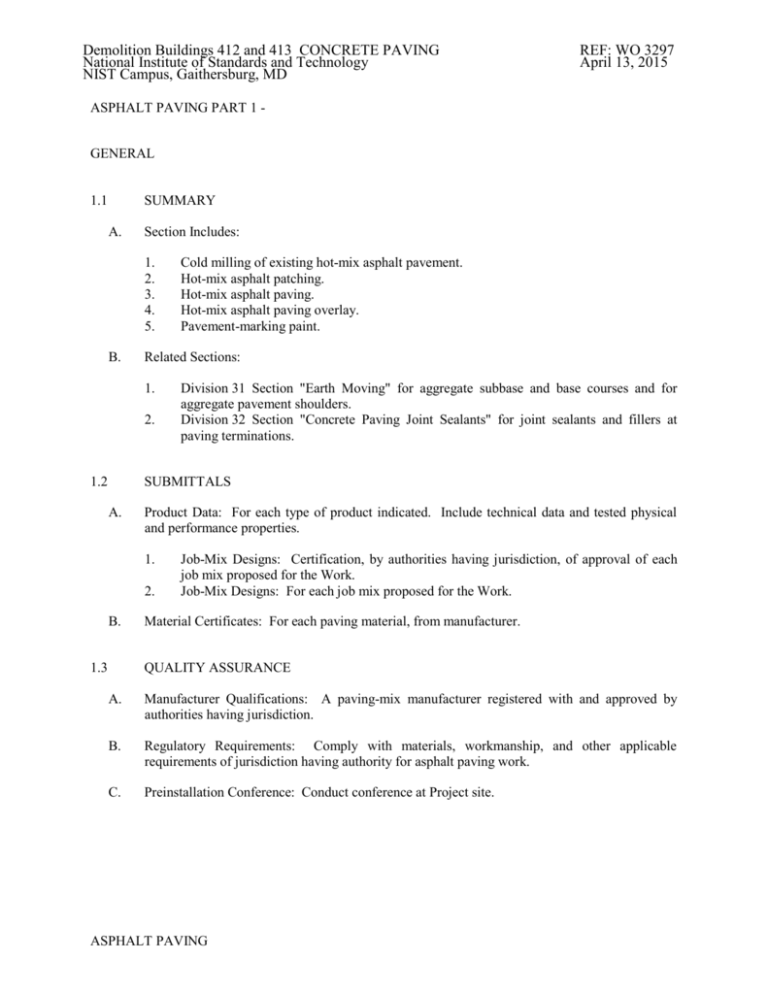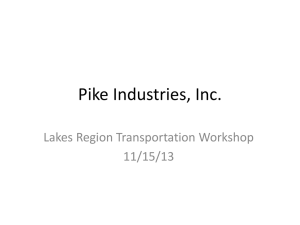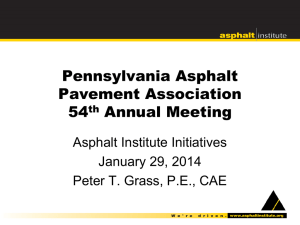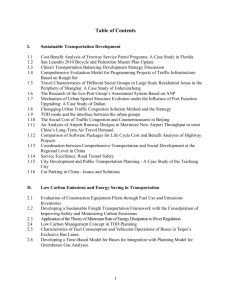ASPHALT-PAVING - Associated Builders Inc.
advertisement

Demolition Buildings 412 and 413 CONCRETE PAVING National Institute of Standards and Technology NIST Campus, Gaithersburg, MD REF: WO 3297 April 13, 2015 ASPHALT PAVING PART 1 GENERAL 1.1 SUMMARY A. Section Includes: 1. 2. 3. 4. 5. B. Related Sections: 1. 2. 1.2 Cold milling of existing hot-mix asphalt pavement. Hot-mix asphalt patching. Hot-mix asphalt paving. Hot-mix asphalt paving overlay. Pavement-marking paint. Division 31 Section "Earth Moving" for aggregate subbase and base courses and for aggregate pavement shoulders. Division 32 Section "Concrete Paving Joint Sealants" for joint sealants and fillers at paving terminations. SUBMITTALS A. Product Data: For each type of product indicated. Include technical data and tested physical and performance properties. 1. 2. B. 1.3 Job-Mix Designs: Certification, by authorities having jurisdiction, of approval of each job mix proposed for the Work. Job-Mix Designs: For each job mix proposed for the Work. Material Certificates: For each paving material, from manufacturer. QUALITY ASSURANCE A. Manufacturer Qualifications: A paving-mix manufacturer registered with and approved by authorities having jurisdiction. B. Regulatory Requirements: Comply with materials, workmanship, and other applicable requirements of jurisdiction having authority for asphalt paving work. C. Preinstallation Conference: Conduct conference at Project site. ASPHALT PAVING 1.4 PROJECT CONDITIONS A. Environmental Limitations: Do not apply asphalt materials if subgrade is wet or excessively damp, if rain is imminent or expected before time required for adequate cure, or if the following conditions are not met: 1. 2. 3. B. Tack Coat: Minimum surface temperature of 60 deg F. Asphalt Base Course: Minimum surface temperature of 40 deg F and rising at time of placement. Asphalt Surface Course: Minimum surface temperature of 60 deg F at time of placement. Pavement-Marking Paint: Proceed with pavement marking only on clean, dry surfaces and at a minimum ambient or surface temperature of 40 deg F for oil-based materials and not exceeding 95 deg F. PART 2 - PRODUCTS 2.1 AGGREGATES A. Coarse Aggregate: ASTM D 692, sound; angular crushed stone, crushed gravel, or cured, crushed blast-furnace slag. B. Fine Aggregate: ASTM D 1073 or AASHTO M 29, sharp-edged natural sand or sand prepared from stone, gravel, cured blast-furnace slag, or combinations thereof. C. Mineral Filler: ASTM D 242 or AASHTO M 17, rock or slag dust, hydraulic cement, or other inert material. 2.2 ASPHALT MATERIALS A. Asphalt Binder: AASHTO M 320 or AASHTO MP 1a, PG 64-22 PG 58-28 PG or 70-22. B. Tack Coat: ASTM D 977 or AASHTO M 140 emulsified asphalt, or ASTM D 2397 or AASHTO M 208 cationic emulsified asphalt, slow setting, diluted in water, of suitable grade and consistency for application. 2.3 AUXILIARY MATERIALS A. Herbicide: Commercial chemical for weed control, registered by the EPA. Provide in granular, liquid, or wettable powder form. B. Pavement-Marking Paint: MPI #32 Alkyd Traffic Marking Paint. 1. C. Color: As indicated. Glass Beads: AASHTO M 247, Type 1. ASPHALT PAVING 2.4 MIXES A. Hot-Mix Asphalt: Dense, hot-laid, hot-mix asphalt plant mixes approved by authorities having jurisdiction; designed according to procedures in AI MS-2, "Mix Design Methods for Asphalt Concrete and Other Hot-Mix Types"; and complying with the following requirements: 1. 2. 3. Provide mixes with a history of satisfactory performance in geographical area where Project is located. Base Course: HMA Superpave (19mm) or approved equal. Surface Course: HMA Superpave (9.5mm) or approved equal. PART 3 - EXECUTION 3.1 EXAMINATION A. Proof-roll subgrade below pavements with heavy pneumatic-tired equipment to identify soft pockets and areas of excess yielding. Do not proof-roll wet or saturated subgrades. B. Proceed with paving only after unsatisfactory conditions have been corrected. 3.2 PATCHING A. Hot-Mix Asphalt Pavement: Saw cut perimeter of patch and excavate existing pavement section to sound base. Excavate rectangular or trapezoidal patches, extending 12 inches into adjacent sound pavement, unless otherwise indicated. Cut excavation faces vertically. Remove excavated material. Recompact existing unbound-aggregate base course to form new subgrade. B. Portland Cement Concrete Pavement: concrete pieces firmly. 1. C. Remove disintegrated or badly cracked pavement. Excavate rectangular or trapezoidal patches, extending into adjacent sound pavement, unless otherwise indicated. Cut excavation faces vertically. Recompact existing unbound-aggregate base course to form new subgrade. Tack Coat: Apply uniformly to vertical surfaces abutting or projecting into new, hot-mix asphalt paving at a rate of 0.05 to 0.15 gal./sq. yd. 1. 2. D. Break cracked slabs and roll as required to reseat Allow tack coat to cure undisturbed before applying hot-mix asphalt paving. Avoid smearing or staining adjoining surfaces, appurtenances, and surroundings. Remove spillages and clean affected surfaces. Patching: Fill excavated pavements with hot-mix asphalt base mix for full thickness of patch and, while still hot, compact flush with adjacent surface. ASPHALT PAVING 3.3 SURFACE PREPARATION A. General: Immediately before placing asphalt materials, remove loose and deleterious material from substrate surfaces. Ensure that prepared subgrade is ready to receive paving. B. Herbicide Treatment: Apply herbicide according to manufacturer's recommended rates and written application instructions. Apply to dry, prepared subgrade or surface of compactedaggregate base before applying paving materials. C. Tack Coat: Apply uniformly to surfaces of existing pavement at a rate of 0.05 to 0.15 gal./sq. yd. 1. 2. 3.4 Allow tack coat to cure undisturbed before applying hot-mix asphalt paving. Avoid smearing or staining adjoining surfaces, appurtenances, and surroundings. Remove spillages and clean affected surfaces. HOT-MIX ASPHALT PLACING A. Machine place hot-mix asphalt on prepared surface, spread uniformly, and strike off. Place asphalt mix by hand to areas inaccessible to equipment in a manner that prevents segregation of mix. Place each course to required grade, cross section, and thickness when compacted. 1. 2. Spread mix at minimum temperature of 250 deg F Regulate paver machine speed to obtain smooth, continuous surface free of pulls and tears in asphalt-paving mat. B. Place paving in consecutive strips not less than 10 feet wide unless infill edge strips of a lesser width are required. C. Promptly correct surface irregularities in paving course behind paver. Use suitable hand tools to remove excess material forming high spots. Fill depressions with hot-mix asphalt to prevent segregation of mix; use suitable hand tools to smooth surface. 3.5 JOINTS A. Construct joints to ensure a continuous bond between adjoining paving sections. Construct joints free of depressions, with same texture and smoothness as other sections of hot-mix asphalt course. 1. 2. 3. 4. Clean contact surfaces and apply tack coat to joints. Offset longitudinal joints, in successive courses, a minimum of 6 inches Offset transverse joints, in successive courses, a minimum of 24 inches Construct transverse joints at each point where paver ends a day's work and resumes work at a subsequent time. Construct these joints using either "bulkhead" or "papered" method according to AI MS-22, for both "Ending a Lane" and "Resumption of Paving Operations." ASPHALT PAVING 3.6 COMPACTION A. General: Begin compaction as soon as placed hot-mix paving will bear roller weight without excessive displacement. Compact hot-mix paving with hot, hand tampers or with vibratoryplate compactors in areas inaccessible to rollers. 1. Complete compaction before mix temperature cools to 185 deg F. B. Breakdown Rolling: Complete breakdown or initial rolling immediately after rolling joints and outside edge. Examine surface immediately after breakdown rolling for indicated crown, grade, and smoothness. Correct laydown and rolling operations to comply with requirements. C. Intermediate Rolling: Begin intermediate rolling immediately after breakdown rolling while hot-mix asphalt is still hot enough to achieve specified density. Continue rolling until hot-mix asphalt course has been uniformly compacted to the following density: 1. Average Density: 92 percent of reference maximum theoretical density according to ASTM D 2041, but not less than 90 percent nor greater than 96 percent. D. Finish Rolling: Finish roll paved surfaces to remove roller marks while hot-mix asphalt is still warm. E. Edge Shaping: While surface is being compacted and finished, trim edges of pavement to proper alignment. Bevel edges while asphalt is still hot; compact thoroughly. F. Protection: After final rolling, do not permit vehicular traffic on pavement until it has cooled and hardened. G. Erect barricades to protect paving from traffic until mixture has cooled enough not to become marked. 3.7 INSTALLATION TOLERANCES A. Pavement Thickness: following tolerances: 1. 2. B. Compact each course to produce the thickness indicated within the Base Course: Plus or minus 1/2 inch. Surface Course: Plus 1/4 inch, no minus. Pavement Surface Smoothness: Compact each course to produce a surface smoothness within the following tolerances as determined by using a 10-foot straightedge applied transversely or longitudinally to paved areas: 1. 2. 3. Base Course: 1/4 inch. Surface Course: 1/8 inch. Crowned Surfaces: Test with crowned template centered and at right angle to crown. Maximum allowable variance from template is 1/4 inch. ASPHALT PAVING 3.8 PAVEMENT MARKING A. Do not apply pavement-marking paint until layout, colors, and placement have been verified with Owner. B. Allow paving to age for 30 days before starting pavement marking. C. Sweep and clean surface to eliminate loose material and dust. D. Apply paint with mechanical equipment to produce pavement markings, of dimensions indicated, with uniform, straight edges. Apply at manufacturer's recommended rates to provide a minimum wet film thickness of 15 mils. 1. 3.9 Broadcast glass beads uniformly into wet pavement markings at a rate of 6 lb/gal. FIELD QUALITY CONTROL A. Testing Agency: Engage a qualified testing agency to perform tests and inspections. B. Replace and compact hot-mix asphalt where core tests were taken. C. Remove and replace or install additional hot-mix asphalt where test results or measurements indicate that it does not comply with specified requirements. 3.10 A. DISPOSAL Except for material indicated to be recycled, remove excavated materials from Project site and legally dispose of them in an EPA-approved landfill. END OF SECTION ASPHALT PAVING







